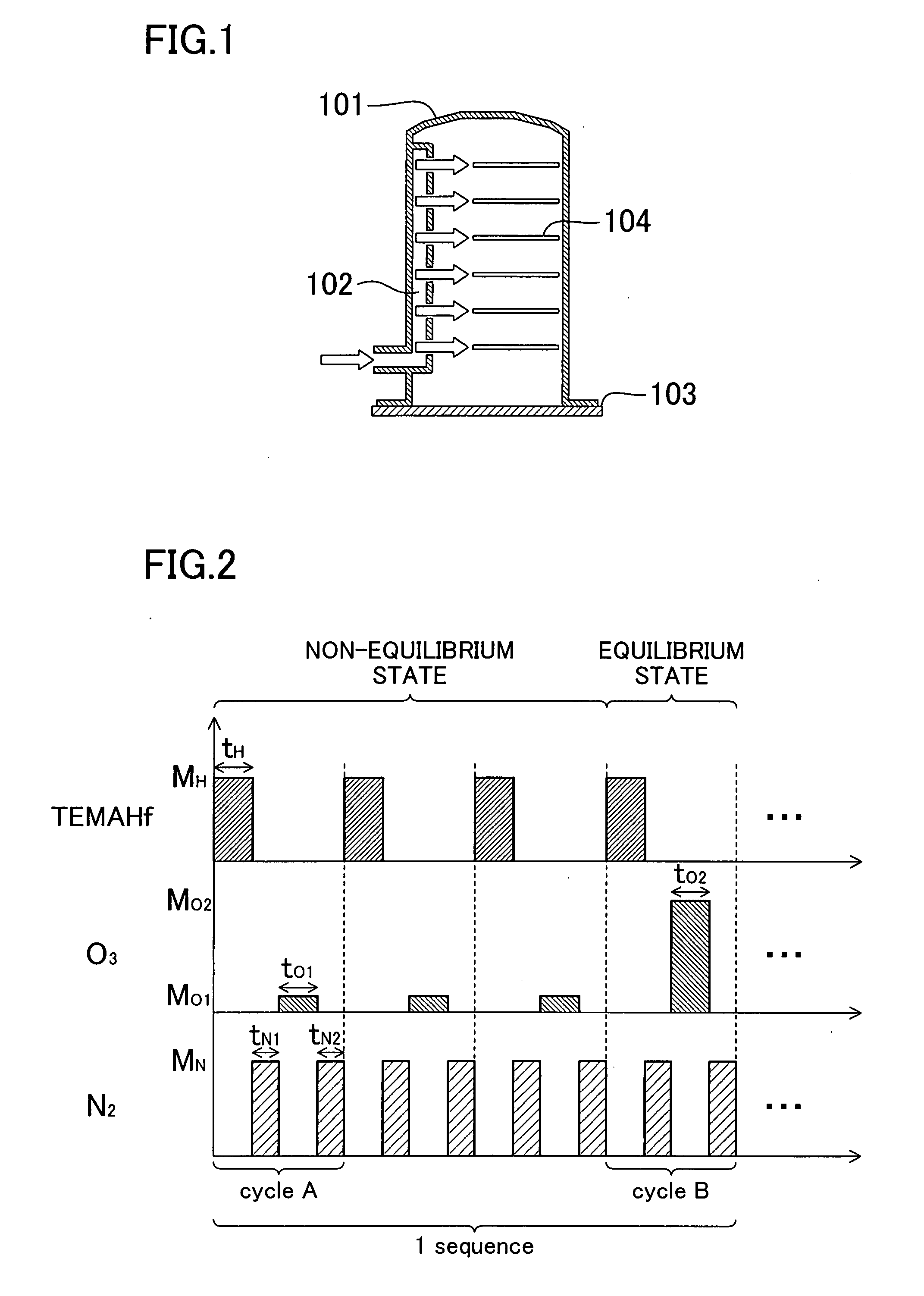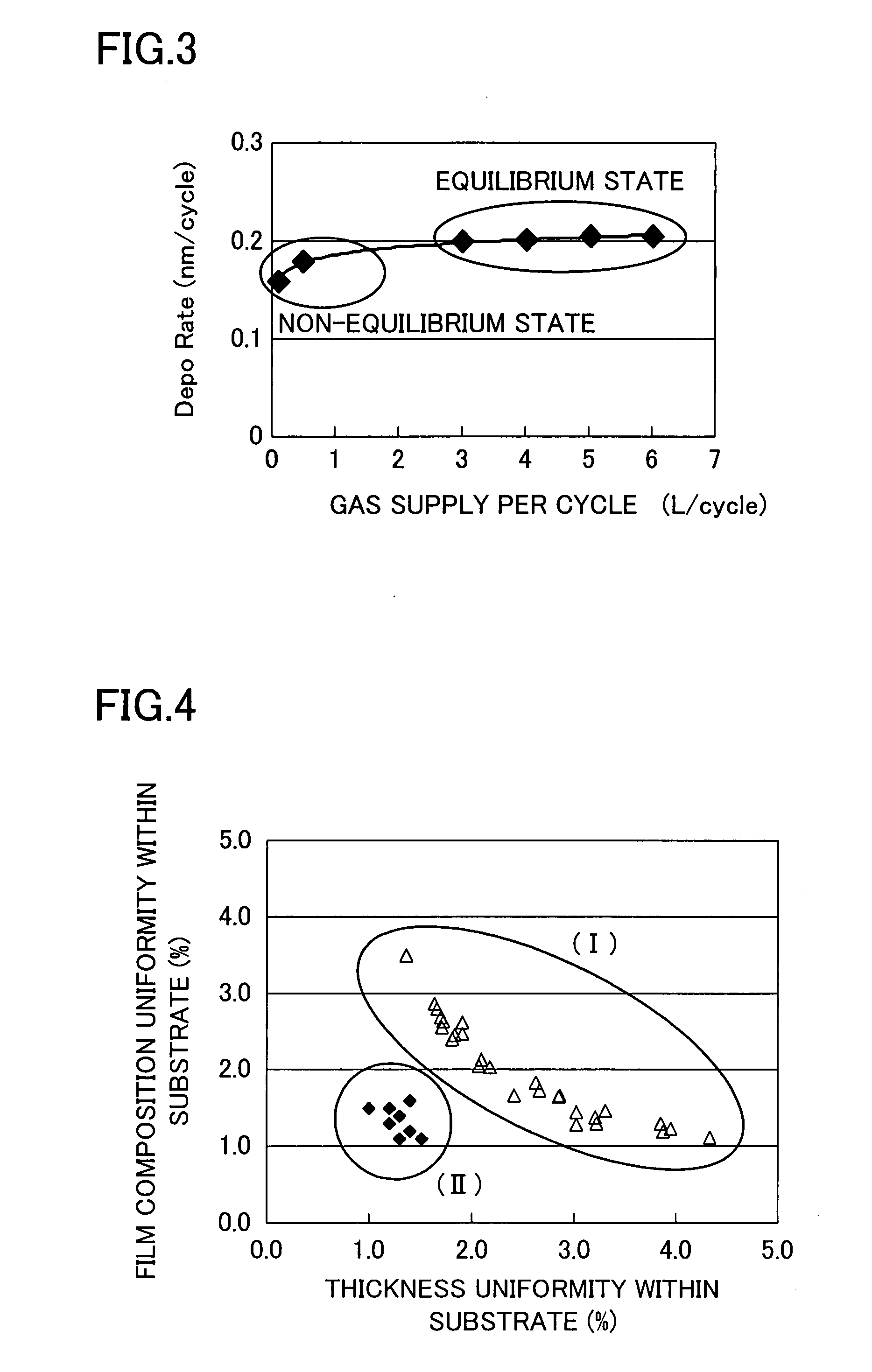Insulating film formation method, semiconductor device, and substrate processing apparatus
a technology of substrate processing and film formation method, which is applied in the direction of polycrystalline material growth, natural mineral layered products, crystal growth process, etc., can solve the problems of insulating film thickness differences, and achieve good thickness uniformity, good thickness uniformity, and good thickness uniformity.
- Summary
- Abstract
- Description
- Claims
- Application Information
AI Technical Summary
Benefits of technology
Problems solved by technology
Method used
Image
Examples
first embodiment
[0034]An insulating film formation method according to a first embodiment of the present invention will be described below with reference to the accompanying drawings. This description will be made exemplarily using formation of a capacitor insulating film made of a hafnium oxide film.
[0035]FIG. 1 is a sectional view showing the structure of a substrate processing apparatus (referred hereinafter to as a first vertical batch ALD apparatus) used in the insulating film formation method according to the first embodiment of the present invention.
[0036]Referring to FIG. 1, the first vertical batch ALD apparatus includes: a reaction chamber 101; a wafer boat (not shown); and a plurality of first nozzles 102. The reaction chamber 101 is used to form an insulating film on each of multiple substrates 104. The wafer boat is used to mount the multiple substrates 104 so that they are aligned at given intervals in the perpendicular direction of the reaction chamber 101. The first nozzles 102 exte...
second embodiment
[0062]An insulating film formation method and a substrate processing apparatus according to a second embodiment of the present invention will be described below with reference to the accompanying drawings. This description will be made exemplarily using formation of a capacitor insulating film made of a hafnium oxide film. FIG. 5 is a sectional view showing the structure of a substrate processing apparatus (referred hereinafter to as a second vertical batch ALD apparatus) according to the second embodiment of the present invention.
[0063]Referring to FIG. 5, the second vertical batch ALD apparatus includes: a reaction chamber 101; a wafer boat (not shown); a plurality of first nozzles 102; and a second nozzle 201. The reaction chamber 101 is used to form an insulating film on each of multiple substrates 104. The wafer boat is used to mount the multiple substrates 104 so that they are aligned at given intervals in the perpendicular direction of the reaction chamber 101. The first nozz...
third embodiment
[0091]A substrate processing apparatus according to a third embodiment of the present invention will be described below with reference to the accompanying drawings. The substrate processing apparatus of the third embodiment (referred hereinafter to as a third vertical batch ALD apparatus) has the structure in which holes provided in a first nozzle are arranged at different positions from those of the first vertical batch ALD apparatus of the first embodiment. FIG. 9 is a top view partly showing the structure of the substrate processing apparatus according to the third embodiment of the present invention.
[0092]Referring to FIG. 9, the third vertical batch ALD apparatus includes: a reaction chamber 101 (not shown); a wafer boat (not shown); and a plurality of first nozzles 102. The reaction chamber 101 is used to form an insulating film on each of multiple substrates 104. The wafer boat is used to mount the multiple substrates 104 so that they are aligned at given intervals in the per...
PUM
| Property | Measurement | Unit |
|---|---|---|
| angle | aaaaa | aaaaa |
| thickness | aaaaa | aaaaa |
| pressure | aaaaa | aaaaa |
Abstract
Description
Claims
Application Information
 Login to View More
Login to View More - R&D
- Intellectual Property
- Life Sciences
- Materials
- Tech Scout
- Unparalleled Data Quality
- Higher Quality Content
- 60% Fewer Hallucinations
Browse by: Latest US Patents, China's latest patents, Technical Efficacy Thesaurus, Application Domain, Technology Topic, Popular Technical Reports.
© 2025 PatSnap. All rights reserved.Legal|Privacy policy|Modern Slavery Act Transparency Statement|Sitemap|About US| Contact US: help@patsnap.com



